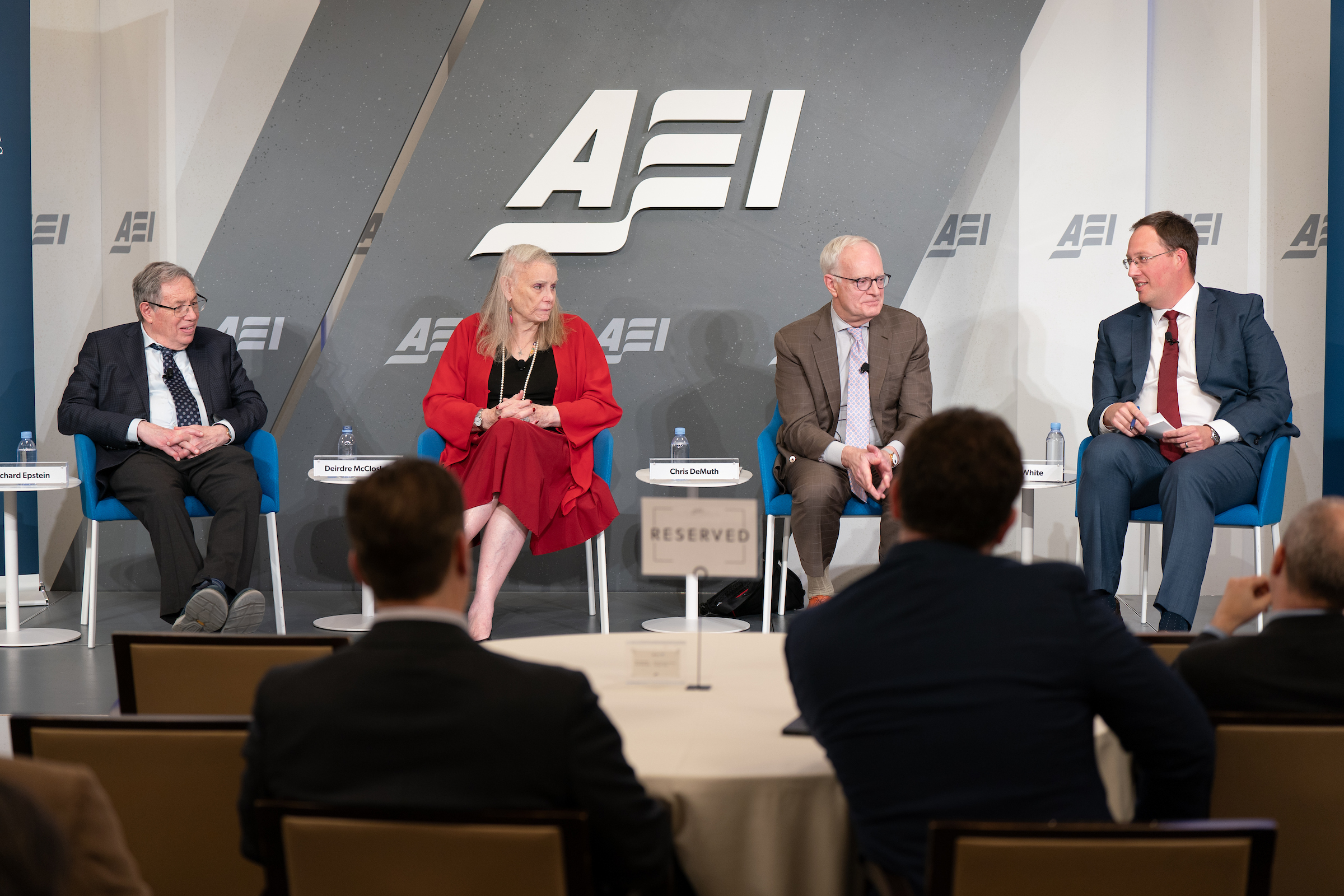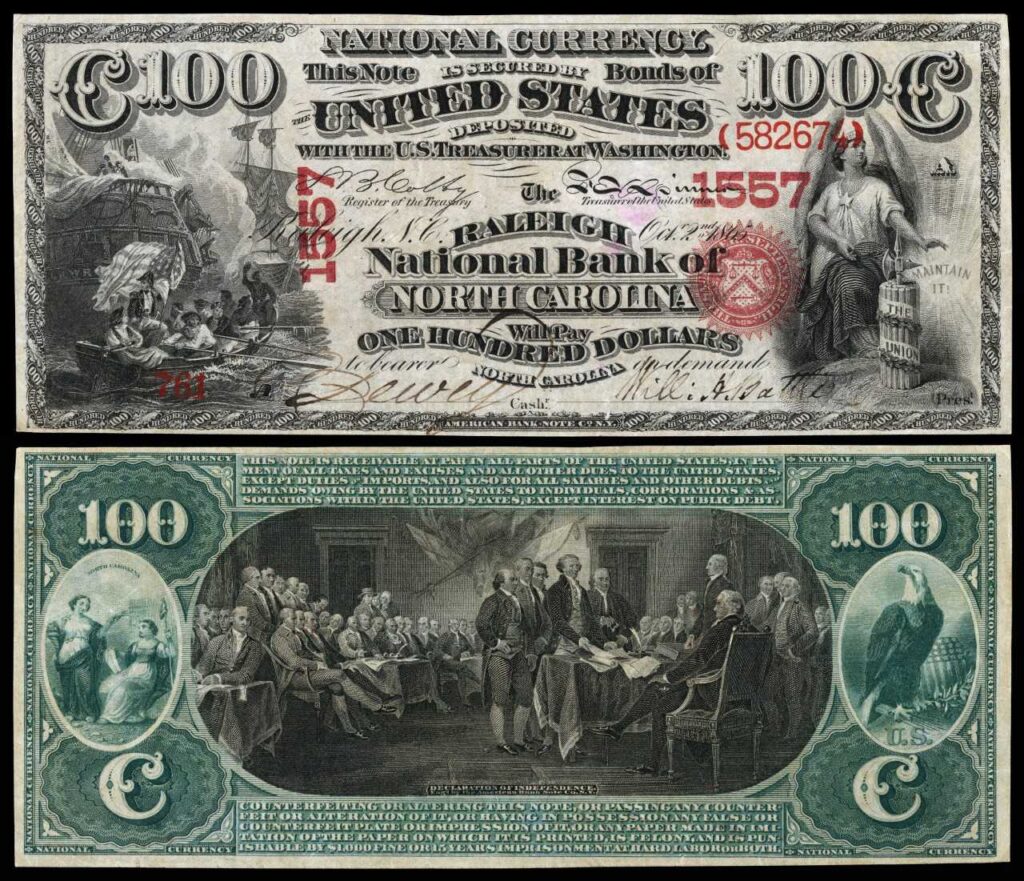Capitalism and the American Revolution
Introduction – Yuval Levin

July 4, 2026, will mark the 250th anniversary of the Declaration of Independence and, therefore, of the United States of America. But the year to which that anniversary points us, the revolutionary year of 1776, also saw a kind of birth announcement for another of the modern West’s great achievements. In March of that year, the Scottish moral philosopher and proto-economist Adam Smith published An Inquiry into the Nature and Causes of the Wealth of Nations. Smith did not invent or launch the market economy, needless to say. But his description of its core assumptions, foundations, and implications stands as a milestone in the history of liberty.
That the United States and what we have come to call capitalism were announced to the world at nearly the same moment is fitting. The United States is now the world’s dominant economy by far, and in most respects, it must be counted the wealthiest society in human history. And it is here that the market economy has played the most definitive role in shaping the ethos of a modern nation. The earliest stirrings of what would become the American Revolution also began as a response to some of the abuses of mercantilism—the economic system that modern capitalism arose to critique and replace.
But was the American Revolution—as some of its champions and some of its critics have claimed—fundamentally an economic uprising? Was it a tax revolt motivated by the interests of wealthy merchants and farmers? How were the arguments for representation, democratic accountability, individual liberty, and universal equality espoused by the revolutionaries related to these economic concerns? To what extent were the passions of the broader American public rooted in the sorts of priorities that would come to define our capitalist ethos? And how did our revolutionary roots then give form to the dynamism, energy, and competitive character of America’s subsequent economic life? Questions like these are essential to understanding the meaning and heritage of the American Revolution. And it is crucial to ask them not cynically but seriously—in ways not intended to disparage the American revolutionaries’ motives and choices but to understand them more fully and therefore also appreciate them more comprehensively.
To better appreciate our country by more fully understanding it is precisely the purpose of the ambitious birthday celebration of which this volume forms a part: The American Enterprise Institute’s “We Hold These Truths: America at 250” initiative. Over several years leading up to the anniversary of the Declaration of Independence, we are inviting scholars both within AEI and from other institutions to take up a series of themes important to understanding the American Revolution. These scholars represent various fields and viewpoints, so they will approach these themes from various angles. The papers they produce will be published in a series of edited volumes intended to help Americans think more deeply and clearly about our nation’s origins, character, and prospects.
Capitalism and the American Revolution is the second of those books. Its chapters began as papers presented at an AEI conference held in Washington, DC, on April 15, 2024. Other volumes in the series consider the American Revolution in relation to other themes, such as democracy, religion, natural rights, the legacy of slavery, and the Constitution.

The provocation involved in approaching our subject under the heading of “capitalism,” rather than “economics” or another more general term, is intentional. We recognize that capitalism began as an epithet and has in some respects become one again. Yet we do not use the term disparagingly. We use it to describe the market economy—its theory and practice, aims and consequences, technical and moral facets, benefits and costs, and ultimately the way of life it describes and to which it is unavoidably attached. To use this term to describe all of that is to self-consciously embrace its champions and critics and seek to learn from both, rather than semantically distance ourselves from one group or the other.
In the chapters that follow, five eminent scholars of economics, history, and public policy consider how we ought to understand modern capitalism and its connection to the American Revolution.
Jay Cost explores the American founders’ deep divisions regarding the character of the American economy. The competing collections of views that ultimately cohered around the followers of Thomas Jefferson and Alexander Hamilton had to do with the deep connections between economic and political priorities, and their disputes reached to the core of the early republic’s politics and remain relevant in our own day. Cost suggests that the American market economy’s development has made it difficult for us to grasp what the Jeffersonians in particular had right—but that recovering a sense of their concerns would be well worth the effort.
Clement Fatovic argues that the American Revolution stemmed from and accelerated powerful trends toward greater social and political equality and that the market character of the American economy had a lot to do with where these trends came from and how they advanced. It was that character of American economic life, he writes, that made the American Revolution not just a repudiation of rule by hereditary elites an ocean away but also a refusal to allow aristocracy to take hold at home.
Deirdre Nansen McCloskey shows that some familiar narratives about the Revolution’s economics are misguided. The Americans were not economically downtrodden or oppressed by the British, and the war made America not wealthier but poorer in the near term. The most important implication of the Revolution was the advancement of the fundamental idea of equal liberty—an idea with important economic dimensions, though it was ultimately a moral claim. And its pursuit in practice has been America’s great gift to the world.
Richard A. Epstein highlights how the legal and jurisprudential consequences of the Revolution made possible the dramatic economic transformation of American life that ultimately followed. The Revolution as a political matter was a sharp break, he argues, but as a legal matter it involved some crucial continuities. And the combination of the two made for a legal order that prioritized commerce, competition, and a freedom of action that facilitated the miracle of America’s subsequent economic growth. But this market-oriented character of American law and constitutionalism has always been controversial and remains intensely contested in our day.
Finally, Christopher DeMuth illustrates how the framework of what he terms “competitive pluralism” characterized the approach of the American founders to economic questions and, ultimately, the deepest kinds of social questions. Drawing on a vast array of examples and evidence, he shows how structured institutional competition has always been key to the distinct character of American public life and that it is evident at the foundation of our economic and political practice. It may harbor the secret to our national success—if we can appreciate its value and continue to apply it.
The range of arguments put forward in these chapters is evidence of the centrality of economic concerns in the thought and action of the American Revolution. But a clear thread nonetheless runs through these varied approaches to the question: Rather than cynically viewing political ideas and movements for change as mere masks for economic interests, we would be wise to understand what we think of as economic concerns as part of a far broader tapestry of interests, forces, and ideas that underlie the public life of a free society. Material and financial concerns don’t stand apart from political philosophy or national interest. They are intertwined to an extent that should warn us away from any simpleminded cynicism. No one is purely an economic actor.
Considering the American Revolution through an economic lens is therefore essential but also insufficient. Like this volume, it is just one of several ways to understand the meaning of our founding on this momentous anniversary—and to celebrate its achievement.

Capitalism and Republicanism in the Founding Era – Jay Cost
It seems as though the left and right can’t agree on anything these days—including the American Revolution. Was it a bold stab for universal liberty? Conservatives say of course it was. Was it another effort by a privileged class to exploit the impoverished masses? Progressives, echoing Marxist critiques from a century or more ago, affirm it was. One of the many problems with polarization is that its relentless Manichaeanism prohibits any kind of nuanced thinking. Everything must be all-or-nothing. And so it is with the Revolution—despite that period’s incredible subtlety, richness of thought, and fascinating ambiguity.
This is the case with many aspects of the American Revolution, but perhaps none more so than its economic aspect. To what extent was the American Revolution capitalistic? The totalitarian mindset of contemporary debate seemingly requires us to answer that the two were one and the same and then debate whether this was a good thing. But in truth, Americans then had decidedly mixed feelings about what we today would call capitalism. Especially if we expand our time horizon to consider not just the Revolutionary War but the building of a new American state—for the 25-year period between the Revolution and Thomas Jefferson’s inauguration—we find an American commitment to capitalism that was equivocal in many respects.
While Americans were nearly unanimous in their support of the rights of private property—holding that the protection of property was one of the central functions of government—they had doubts about many institutions of modern capitalism, or at least contemporary efforts to bring them about. Classical antiquity had taught many of them to be skeptical of wealth inequality, and the Financial and Industrial Revolutions happening in Great Britain likewise inculcated in them a deep mistrust of any political economy that would de-emphasize landownership, which they believed was the great equalizing force in American politics. This group would eventually cohere around the personality of Jefferson, largely in opposition to Alexander Hamilton. An ardent believer in the benevolent effects of economic growth, Hamilton sought to bootstrap the United States into a world power by adopting many of the policies employed in Great Britain.
This divide touched off a heated and sustained political battle, which was resolved only when Jefferson won the presidency in 1800. And while today we take for granted that Hamiltonian economics were superior, we must at the same time acknowledge that the Jeffersonians got the politics more than a little right. Vast inequalities in wealth can and do lead to inequality of political power, which in turn challenges the republican character of our regime. One need not reject the virtues of capitalism to accept that this is one vice. It would behoove us in the 21st century to reconsider this Jeffersonian critique and think through ways we can live in a dynamic capitalist economy that nevertheless treats citizens as truly politically equal.
(more…)The American Revolution and the Pursuit of Economic Equality – Clement Fatovic
We have grown so accustomed to the phrase “American Revolution” that it is difficult to imagine an alternative label for the events that ultimately resulted in the permanent separation of 13 American colonies from Great Britain. Participants and observers had used the terms “conflict,” “struggle,” “resistance,” “crisis,” “war,” and even “rebellion” to frame these events, but they were slow to adopt the term “revolution.” The opposing sides had been engaged in actual combat for several years before Americans and their allies consistently began to describe what was happening as revolution.1 Therefore, it is important to consider what Americans at the time meant—or aspired to—in calling their undertaking a revolution.
As assiduous students of political history, Americans in that period would have understood that revolutions are radical affairs.2 The transformation of the political order from colonial dependence on an imperial monarchy an ocean away to a self-governing country resting at least nominally on the people’s sovereignty was certainly a radical change. But if a change in their relationship to Great Britain was all Americans had in mind, the word “independence” would have sufficed. In adopting the word “revolution,” they signaled that they were also participating in a radical transformation of the social and economic order. In other words, the American Revolution was both a political and a social revolution.
The social revolution was not a sudden development but rather, like the political events that ultimately culminated in a declaration of independence, the result of a protracted process decades in the making. Americans at the time generally understood that the political and social dimensions of the American Revolution both revolved around the idea of equality. Taking up Thomas Paine’s challenge in Common Sense to “begin the world over again,”3 Americans did not just seek to make themselves independent—they also set out to remake their societies.
My central claim in this chapter is that the American Revolution developed, accelerated, and expanded trends toward greater equality that had been underway for decades and inaugurated new ones that would unfold over the coming centuries, if only fitfully and still incompletely. Despite significant variations in economic and social structures among the British colonies—from the Eastern Seaboard to islands in the Caribbean and the mid-Atlantic—social relations between women and men, blacks and whites, servile and free, poor and rich, and (at least in New England) lay and clergy at the start of the century were organized hierarchically, and deeply rooted norms and habits of deference shaped relations between political leaders and their constituents.4 Occasional and highly localized bursts of dissent did little to alter relations of subordination in vertically structured societies where the few often felt entitled to rule by virtue of their status.5
Even if colonists had moved away from the belief of early 17th-century Massachusetts Gov. John Winthrop that some were born “high and eminent in power and dignity, others mean and in subjection,”6 Americans through the first half of the 18th century still generally believed that each individual belonged to an assigned place in society. By all indications, everyone seemed content to be the subject of a king even several years into the conflict with Britain. But by the time Americans settled on the label “American Revolution,” they had not only renounced domination by elites in Great Britain but also begun to question the legitimacy of domination by elites at home.
(more…)Economic Causes and Consequences of the American Revolution – Deirdre Nansen McCloskey
How can we weigh the costs and benefits of the American Revolution? Even if we tried to do so in material terms, we would have to begin by considering the revolt’s sheer human scope. War is hell, and the American Revolution began with a society-wide war.
Historians of the events from the Boston Tea Party in 1773 through Yorktown in 1781 and the Treaty of Paris in 1783 agree the Revolution was a civil war—the first of two shooting wars determining how Americans would govern themselves. According to the conventional account of the combatants in this first civil war, in 1780 about a third of the roughly 2,100,000 free citizens of the British colonies that became the United States would have described themselves, with mixed idealism and self-interest, as Patriots.1 Another third were loyal to the British Empire.
Threatened with being tarred and feathered, having their property seized, and worse, about 60,000 of the roughly 700,000 Loyalists had decamped to Canada or Britain by 1783.2 The decamping is noteworthy and considerably affected Canadian history, but it was nowhere close to the entire group. The 91 percent of Loyalists who lingered into the early republic perhaps found their voice as conservative moderates restraining their fellow citizens’ wilder democratic impulses. The final third of the colonists occupied the uneasy middle—what we have come to call in American politics the independents. They were not willing to pledge their lives, fortunes, and sacred honor to a bloody, collective exit from the British Empire or a fierce, and also bloody, loyalty to king and country.
Historians calculate that 25,000 to 70,000 Patriots died directly because of the war, killed by camp fever and musket fire. Some 7,000 Loyalists did too. An additional 130,000 Americans were killed by a spike in smallpox that the movement of populations during the war exacerbated.3 The war, in other words, was seriously disruptive due to the death, injury, disease, property damage, territorial occupations, and naval blockades it caused.
In America’s other civil war, from 1861 to 1865, 1.8 percent of the country’s combined population—Northerners and Southerners, free and enslaved—died as soldiers, and doubtlessly, numerous civilians in the South died during the suppression of the rebellion.4 But during the first civil war, even setting aside deaths from smallpox and taking the lower estimate of Patriot soldiers’ deaths, when we combine that number with Loyalists’ deaths, we find that nearly as many died relative to the population as in the second civil war: fully 1.5 percent of merely the free Americans in 1776. Compared with the guillotining of French nobles and prison deaths from maltreatment during the French Revolution’s Reign of Terror, in the American Revolution, fully 11 times more soldiers died relative to the population at risk. (In France, of course, Napoleon Bonaparte later vastly extended the slaughter.)
Taking the higher 75,000 figure for Patriots’ war deaths in the American Revolution would imply that such deaths alone amounted to almost 4 percent of the free population. By comparison, about one-third of 1 percent of the American population died in World War II.5 The Revolution was assuredly a bloody business. Its human cost was very high.
But was it a profane, mere “business” or a holy, sacred devotion? What can we make of the material and economic arguments for the Revolution? And what can we say about its implications for the former colonies’ prosperity?
(more…)Laying the Foundations for a Market Economy – Richard A. Epstein
The political separation pursued by the American founding was sharp and violent. But the transition to an independent American legal order was far less so. Note, for instance, the continuity between two systems in Article XXV of the 1777 New York Constitution:
And this convention doth further, in the name and by the authority of the good people of this State, ordain, determine, and declare that such parts of the common law of England, and of the statute law of England and Great Britain, and of the acts of the legislature of the colony of New York, as together did form the law of the said colony on [April 19, 1777] shall be and continue the law of this State, subject to such alterations and provisions as the legislature of this State shall, from time to time, make concerning the same.1
Nor was this the only way in which the new regime derived from the old. The American constitutional system ultimately contained many features that were partial departures from the English model (like having a president and not a king). But much of its federal system was an adaptation that put the federal government in the place of the English government and left most of the governing to the states, deploying only (what seemed at the time) enumerated powers to define the federal government’s role.
This relatively smooth doctrinal transition makes it possible to examine the American system in light of the English one. Unsurprisingly, many of the tensions evident in legal debates in Great Britain, which was in the midst of its first industrial revolution, carried over to the United States. This was especially true with what we would now call economic policy.
In the founding period (which for legal-history purposes we might say extends from 1776 to about 1835, with John Marshall’s death), dealing with these issues was compounded by a set of conceptual obstacles that did not get resolved until the 19th century. Laissez-faire economics were at best in their infancy. The term “capitalism,” with its largely negative connotations, also lay in the future.
The social welfare implications of competition versus monopoly were not yet worked out, so the defense of classical-liberal principles of limited government and strong property rights was captured largely in the term “commercial republic,” which obviously understated the role that manufacturing, mining, and agriculture would play both during and after the founding period. It was therefore with a limited set of analytical tools that early Americans confronted many basic questions about the character of the commercial economy then emerging on both sides of the Atlantic.
At the heart of these tensions lay the constant struggle between protectionism and competition. And the nascent American political order addressed these tensions and that struggle in a complex way that would set the pattern for American economic debates ever since. That pattern is especially evident in the Constitution’s structure and some early legal debates about its implementation.
The American Constitution was a charter in two major directions: Key structural provisions govern the relationship between the central government and the states on the one hand and between the divided powers in the federal government on the other. Further provisions gave protection to individual rights.
Most, but not all of these, were conducive to the market economy or capitalism as we now know it. But never in any simple way. And working out the place of markets, competition, and trade in the life of the new republic was a constant preoccupation of the courts in the nation’s first half century. This is evident in a broad range of cases and controversies but can be illuminated by considering a few key domains in particular.
(more…)Colonial Capitalism and the American Founding – Christopher DeMuth
The American founding was a momentous event in the development of modern government. It was similarly momentous in the development of modern capitalism. Our economic founding, however, was more evolutionary than revolutionary. By 1776, the 150-year colonial period had already generated a distinctive American capitalism. Political independence and the Constitution of 1787 gave that capitalism an institutional structure and a new purpose—to build a prosperous, democratic, continental nation.
The colonial era was a time of historic advances in manufacturing, finance, trade, and transportation, epitomized by the Dutch golden age of the 17th century and the first Industrial Revolution of the 18th century. The new ideas and practices originated in America’s two progenitor nations, Great Britain and the Dutch Republic, and they accompanied the settlers to the New World. Here they were adapted and improved by a highly enterprising citizenry, surrounded by a staggering abundance of land and other natural resources, in circumstances that demanded creative improvisation and gave ample rein to commercial spirits.
By the later 1700s, Britain’s American colonies had grown prosperous, with active markets, the widespread availability of credit, and, in the north, a substantial middle class. But the mother country remained bent on colonial mercantilism and political domination. Many of the grievances that precipitated the Revolution were economic and commercial, such as the British Trade and Navigation Acts running back to the 1620s, the settlement provisions of the Proclamation of 1763, the trade provisions of the Quebec Act of 1774, and various “taxes without representation.” The short-lived Stamp Act of 1765 was a deeply resented imposition on commercial and property transactions in the colonies.
When independence had been won and the new nation began building its own political institutions, the founders faced many urgent questions of economic liberty, commercial regulation, and finance. The Constitutional Convention of 1787 was convened to address the Articles of Confederation’s economic weaknesses—the national government’s lack of authority over taxation, currency, foreign trade, and commercial quarrels within and among states. The Constitution included numerous provisions protecting property and contract, promoting domestic and foreign commerce, and ordaining limited government, which were enforced by early Supreme Courts. The first business of the Washington administration and the First Congress (other than drafting a bill of rights) was enacting import tariffs to promote domestic manufacturing and raise government revenue, funding continental and state war debts, and establishing a banking system and national currency.
In the 1982 predecessor to this volume—the American Enterprise Institute’s (AEI) How Capitalistic Is the Constitution?1—the seven essayists agreed that the founding was capitalistic but disagreed over causes and consequences. Was our founding capitalism elitist and based on class (top-down) or democratic and populist (bottom-up)? How did this capitalism affect the course of American politics, society, and prosperity? How was it altered by subsequent events—wars and social movements, economic booms and busts, industrialization and urbanization, and the policy transformations of the Progressive and New Deal eras and the welfare state?
(more…)Symposium Video
In the second symposium of the “We Hold These Truths: America at 250” initiative held at AEI on April 15, 2024, historians, political scientists, and economists analyzed the role that the market economy played in the creation of the United States. The Heritage Foundation’s Chris DeMuth described how the American colonial and founding periods established competitive pluralism as a defining characteristic of American life, while the University of Illinois at Chicago’s Deirdre McCloskey argued that war and independence were not necessary to expand America’s “key peculiarity” of equality of permission that had developed in the colonial period. Richard Epstein of the New York University School of Law traced how the patent system, a national bank, and the Constitution’s lack of protection of national commerce enabled the nation’s economic advancement. The event concluded with a moderated discussion between Florida International University’s Clement Fatovic and AEI’s Jay Cost on how the Revolution both weakened the links between class and power and inaugurated an enduring tension between capitalism and civic republicanism.
Freedom in a Revolutionary Economy
By G. Warren Nutter

In his 1974 Bicentennial lecture, the economist G. Warren Nutter examines how America’s founding economic principles have evolved over two centuries. Dr. Nutter explores Adam Smith’s influence on the founders and the political system they designed, which prioritized free markets and voluntary exchange and placed strict limits on government’s economic role. Over time, however, this emphasis on individual liberty, private property, and limited government began to compete with increasing public demands for government intervention. Generated less by market failures than by growing prosperity, these demands reflected a shift in social values that prioritized security and equality above economic freedom. Dr. Nutter also chronicles how over time, courts, contract law, and the economic institutions that once reinforced individual autonomy gave way to a new ethos of state-driven economic management.
This lecture isn’t simply a history lesson—it’s a warning. Dr. Nutter contends that America has steadily drifted from its revolutionary economic foundations, risking the very freedoms that made its prosperity possible. He challenges the notion that government is the best solution to market inefficiencies, cautioning that unchecked expansion of state power could stifle the dynamism that defined American enterprise at its inception.








